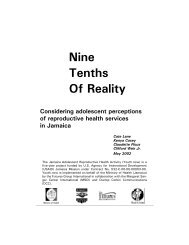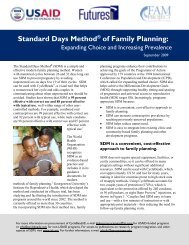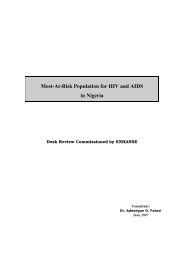Health Policy Issues and Health Programmes in ... - Amazon S3
Health Policy Issues and Health Programmes in ... - Amazon S3
Health Policy Issues and Health Programmes in ... - Amazon S3
- No tags were found...
Create successful ePaper yourself
Turn your PDF publications into a flip-book with our unique Google optimized e-Paper software.
HIV/AIDS <strong>in</strong> India <strong>and</strong> UttaranchalFigure 2Percentage3.02.52.01.51.00.5Sent<strong>in</strong>el Surveillance for HIV InfectionHIV prevalence among antenatal wom en <strong>in</strong>metropolitan cities–1998attendees, <strong>and</strong> is now steadily spread<strong>in</strong>g throughout thelow-risk population (Figure 3). The time lag for HIV<strong>in</strong>fection to spread from high-risk groups to low-riskgroups is between three <strong>and</strong> five years. The <strong>in</strong>fectionspreads from CSWs to their clients, which act as a bridgepopulation, <strong>and</strong> then to the clients’ wives.Among IDUs, the <strong>in</strong>fection has spread sharply <strong>in</strong>Manipur, with HIV prevalence at more than 70% (Figure4). It is also spread<strong>in</strong>g <strong>in</strong> Nagal<strong>and</strong>.0Figure 3MumbaiHyderabadBangaloreChennaiCalcuttaAhmedabadD elhiHIV prevalence Maharashtra <strong>in</strong> three sub groupsW<strong>in</strong>dows of opportunities for other states757065605550454035302520151050CSWSTDANCTime lag <strong>in</strong>fectionhigh to low risk(3-5 years)Source: NACO, 1998Figure 49080HIV prevalence among IDU <strong>in</strong> ManipurTrends of HIV <strong>in</strong>fection among various risk groups <strong>in</strong>India, especially among the states, can be summarized asfollows.l Although HIV prevalence is low <strong>in</strong> the majority ofstates, the number of HIV <strong>in</strong>fections is high.l There are wide regional variations <strong>in</strong> HIV prevalence.l There are simultaneous epidemics <strong>in</strong> certa<strong>in</strong> states,such as the heterosexual epidemic <strong>in</strong> Maharashtra<strong>and</strong> Tamil Nadu, <strong>and</strong> the IDU epidemic <strong>in</strong> Manipur.Estimation of HIV Infection among theAdult Population, 2001In the Indian context, it is difficult to estimate the exactprevalence of HIV because of the varied culturalcharacteristics, traditions, <strong>and</strong> values with specialreference to sex-related risk behaviours. The westernAfrican model of mak<strong>in</strong>g estimates cannot be easilyapplied to the Indian scenario; however, it is possible tohave rough estimates with<strong>in</strong> a range that may be used forplann<strong>in</strong>g of the AIDS Prevention <strong>and</strong> ControlProgramme. These estimates can also be useful formapp<strong>in</strong>g specific vulnerable groups <strong>and</strong> areas <strong>in</strong> order toplan targeted <strong>in</strong>terventions <strong>in</strong> major urban areas <strong>and</strong>other areas <strong>in</strong> the states.Percentage706050403020100To estimate the total burden of HIV <strong>in</strong>fection <strong>in</strong> thecountry, some effort was made previously by the World<strong>Health</strong> Organization (WHO) <strong>and</strong> UNAIDS by us<strong>in</strong>g thedata generated by the National AIDS ControlOrganization (NACO) <strong>and</strong> other publications fromvarious research <strong>in</strong>stitutes <strong>in</strong> India. Although the HIVsent<strong>in</strong>el surveillance data have been primarily used formonitor<strong>in</strong>g trends (i.e., to assess how rapidly HIV178







